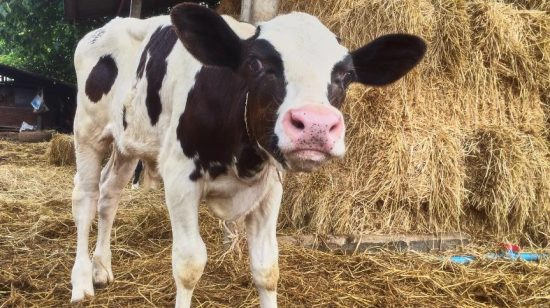How Long Do Goldfish Live? Find Out Their Lifespan Here.
Explore the lifespan of your finned friends! Discover how long do goldfish live in optimal conditions and learn key care tips for longevity.
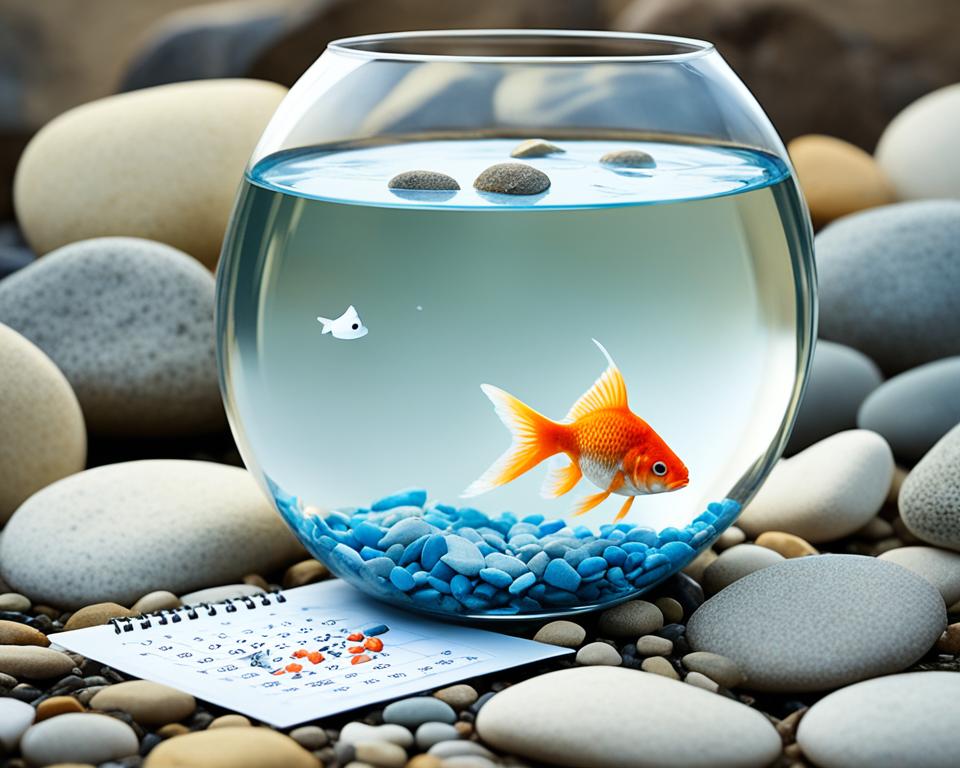
Have you ever wondered how long do goldfish live? Are they destined to be short-lived pets or can they actually live for several years? The answer might surprise you. Goldfish lifespan can vary depending on a multitude of factors, from their specific breed to the care they receive. While it is commonly believed that goldfish have a short lifespan, in reality, they have the potential to live much longer. On average, goldfish can live for 10-15 years, but some varieties have been known to surpass this and live well into their 30s. Imagine having a pet that stays with you for over three decades!
A Deep Dive Into the Lifespan of Goldfish
Goldfish, beloved pets known for their vibrant colors and graceful swimming, have captivated the hearts of many. But have you ever wondered how long these finned friends can actually live? In this section, we will explore the intricacies of goldfish lifespan, shedding light on the factors that contribute to their longevity.
Understanding Goldfish Lifespan Variability
The lifespan of a goldfish can vary significantly depending on various factors, such as genetics, environment, and care. While the average lifespan of a goldfish is typically around 10-15 years, there are documented cases of these aquatic wonders living well into their 30s and even longer.
Genetics play a crucial role in goldfish lifespan variability. Different breeds and varieties of goldfish have their own unique genetic makeup, which can influence their potential for a longer lifespan. By understanding the genetic predispositions of specific goldfish breeds, owners can better cater to their needs and provide appropriate care.
Moreover, the environment in which a goldfish lives can also impact its lifespan. Factors such as water quality, tank size, and temperature can significantly affect the overall health and longevity of goldfish. Providing a clean and spacious habitat with optimal conditions is paramount for ensuring their well-being.
Documented Cases of Long-Lived Goldfish
Goldfish enthusiasts around the world have shared remarkable stories of their long-lived companions. Some goldfish have defied expectations, surpassing the average lifespan significantly. A living testament to the potential for exceptional longevity in goldfish is the case of Tish, a goldfish that lived for a remarkable 43 years. Tish’s story serves as a reminder of the inherent resilience and capacity for survival in these beautiful creatures.
From this unprecedented case to numerous stories of goldfish living well into their 30s, it’s clear that with proper care and environmental conditions, goldfish have the potential to live well beyond the average lifespan.
| Goldfish Breed | Average Lifespan (years) |
|---|---|
| Common Goldfish | 10-15 |
| Fantail Goldfish | 10-15 |
| Oranda Goldfish | 10-15 |
| Lionhead Goldfish | 10-15 |
| Ryukin Goldfish | 10-15 |
| Ranchu Goldfish | 10-15 |
| Shubunkin Goldfish | 10-15 |
| Comet Goldfish | 10-15 |
| Telescope Goldfish | 10-15 |
| Bubble Eye Goldfish | 10-15 |
The Impact of Environment on Goldfish Longevity
The environment in which goldfish are raised plays a crucial role in their longevity. Several factors, including water quality, tank size, and habitat conditions, can significantly impact their lifespan. Providing a suitable and well-maintained environment is vital for ensuring the longevity of these beloved pets.
One of the main factors influencing the lifespan of goldfish is water quality. Goldfish are sensitive creatures that require clean and properly balanced water to thrive. Poor water quality can lead to stress, disease, and a shortened lifespan. Regular water testing and maintenance are essential to prevent harmful fluctuations in pH levels and the accumulation of toxins.
Tank size is another aspect that affects goldfish longevity. Goldfish thrive in spacious environments where they have enough room to swim and grow. A small tank restricts their movement, leading to stunted growth and a decreased lifespan. It is recommended to provide a tank with a capacity of at least 20 gallons for a single goldfish, with additional space for every additional fish.
Creating a habitat that closely resembles the fish’s natural environment is also crucial for the fish’s well-being and lifespan. Incorporating plants, rocks, and other decorations not only provides visual appeal but also stimulates natural behaviors and reduces stress. Adding hiding spots and providing proper lighting contribute to a healthier and happier goldfish.
By paying attention to the environmental factors that influence goldfish longevity, you can help ensure that your goldfish live a long and healthy life. Maintaining clean water, providing adequate space, and creating a stimulating habitat are key to promoting their well-being and maximizing their lifespan.
| Environmental Factors | Impact on Goldfish Longevity |
|---|---|
| Water quality | Deteriorates lifespan if not properly maintained |
| Tank size | Restricted space leads to stunted growth and shorter lifespan |
| Habitat conditions | Stress reduction and stimulation contribute to a longer lifespan |
How Long Do Goldfish Live?
Goldfish have the potential to live for varying lengths of time depending on their habitat. Different habitats, such as ponds and tanks, can significantly impact their lifespan.
In larger ponds with ample space and appropriate care, goldfish can thrive and live well into their 20s or even 30s. The spacious pond environment allows goldfish to swim freely and engage in natural behaviors, contributing to their overall well-being and extended lifespan.
On the other hand, goldfish kept in smaller tanks or bowls may experience a shorter lifespan. The limited space and potentially inadequate conditions in these confined habitats can restrict the goldfish’s ability to grow and thrive. Consequently, their lifespan may be significantly reduced compared to those living in larger habitats.
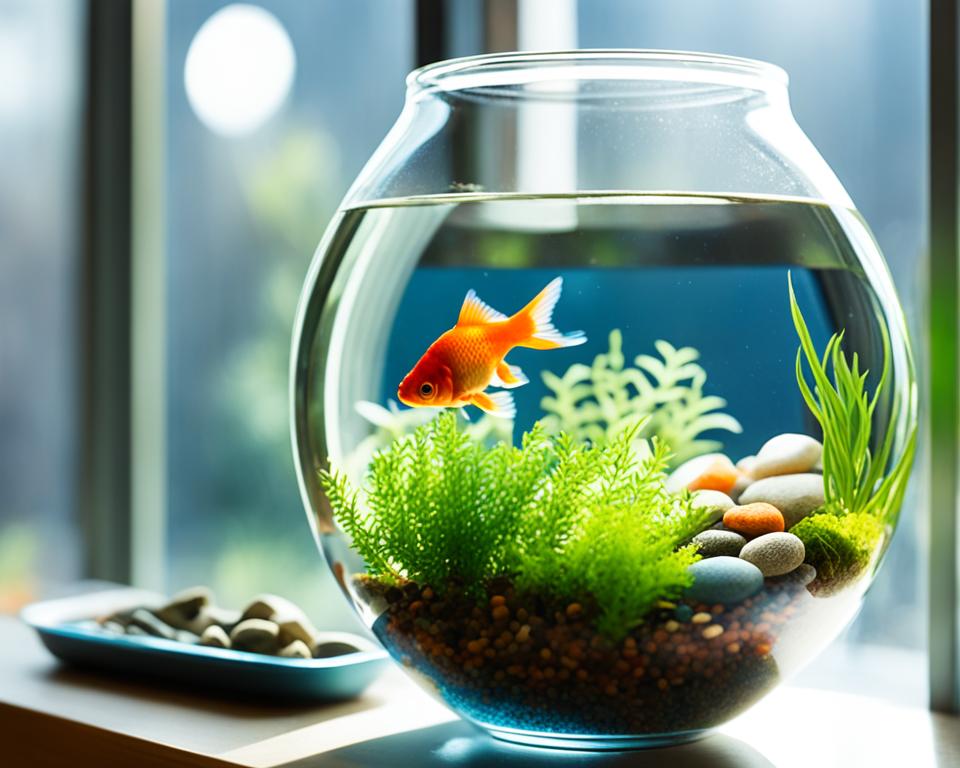
The size and conditions of the habitat play a crucial role in determining the lifespan of goldfish. Providing a spacious and well-maintained environment, such as a pond or a sufficiently large tank, can greatly increase the longevity of goldfish.
Factors Affecting the Survival of Goldfish
Various factors affect the survival and longevity of goldfish. Two key factors that significantly impact their lifespan are goldfish breeding practices and the overcrowding of tanks or ponds.
Goldfish breeding practices can directly impact the size and shape of these aquatic pets, which, in turn, can affect their overall lifespan. Selective breeding for certain traits or physical characteristics may lead to genetic issues or health problems that can shorten their lifespan.
It is important to consider responsible goldfish breeding methods that prioritize the fish’s health and well-being. Breeding for strong genetics and avoiding excessive inbreeding can increase the chances of longer lifespans for goldfish offspring.
Overcrowding Vs. Healthy Goldfish Population Management
Overcrowding is another significant factor that can impact the survival of goldfish. When goldfish are housed in tanks or ponds with limited space, overcrowding can lead to increased stress, resource competition, and a shorter lifespan.
Implementing proper population management practices, such as maintaining a healthy fish-to-water ratio and providing adequate space for each goldfish, ensures their longevity. By avoiding overcrowding, goldfish can thrive in a more natural and stress-free environment, contributing to their overall health and lifespan.
A well-maintained and suitable environment, responsible breeding practices, and healthy population management are key factors that can positively affect the survival and lifespan of goldfish.
Proper Care for Maximizing Goldfish Lifespan
Providing proper care is essential for maximizing the lifespan of goldfish. This includes ensuring proper filtration and aeration in the tank to maintain a healthy environment for the fish. Goldfish produce a significant amount of waste, which can quickly degrade the water quality if not properly managed. Filtration systems help remove debris and harmful substances, ensuring clean and oxygenated water for your goldfish.
Essential Tips for Goldfish Filtration and Aeration
When it comes to goldfish filtration and aeration, there are a few key factors to consider:
- Choose the right filter: Selecting a filter that is appropriate for the size of your tank is crucial. Different types of filters, such as hang-on-back filters, sponge filters, or canister filters, offer various levels of filtration and aeration.
- Maintain a proper flow rate: Ensure that the flow rate of your filter is suitable for your goldfish. A gentle and steady flow will provide adequate oxygenation without causing excessive disturbance.
- Clean the filter regularly: Regular maintenance, including cleaning and replacement of filter media, is necessary to keep the filtration system functioning optimally. Follow the manufacturer’s instructions for proper maintenance.
- Consider additional aeration: In addition to filtration, providing supplemental aeration, such as with an air pump and air stone, can further enhance the oxygen levels in the tank.
Nutrition’s Role in Goldfish Longevity
Proper nutrition plays a significant role in the longevity of goldfish. Feeding your goldfish a balanced diet is essential for their overall health and lifespan. By providing the right nutrients, you can help support their immune system, enhance their coloration, and promote their well-being.
When it comes to feeding goldfish, high-quality fish flakes or pellets should be the main staple of their diet. These commercially available foods are specifically formulated to provide the necessary nutrients for goldfish. Look for products that contain a mix of proteins, fats, and carbohydrates to ensure a well-rounded diet.
Supplementing their diet with occasional vegetable treats can provide added nutrition. Goldfish enjoy nibbling on blanched peas, cucumbers, and spinach. These vegetables offer fiber and essential vitamins that contribute to their overall health.
Enhance their diet is by offering live or frozen food. Bloodworms, daphnia, and brine shrimp can be excellent sources of protein. These foods simulate the variety of their natural diet and can enrich your goldfish’s diet.
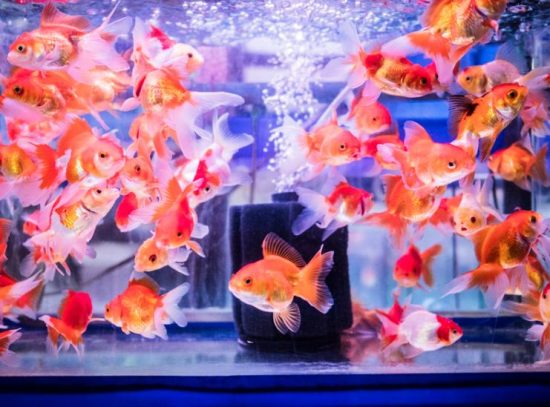
It’s important to note that goldfish have small stomachs and can easily overeat. Overfeeding can lead to health issues such as obesity and poor water quality. To prevent overfeeding, feed your goldfish small portions several times a day, only giving them what they can consume within a few minutes.
The water quality in your goldfish tank or pond can also impact their nutrition and overall health. Regularly testing and maintaining water parameters such as ammonia, nitrite, and nitrate levels is crucial. Clean and well-filtered water can help ensure that your goldfish are getting the most out of their diet.
How Various Goldfish Types Differ in Lifespan
Different types of goldfish exhibit varying lifespans. Understanding the expected lifespans of common and fancy goldfish, as well as the wide range of varieties available, can help goldfish owners make informed decisions about their pets’ care and well-being.
Expected Lifespans of Common and Fancy Goldfish
Common goldfish, also known as feeder goldfish, are the most basic and widely recognized type of goldfish. These resilient fish can typically live for 10-15 years under proper care conditions. Common goldfish are known for their vibrant colors, graceful movement, and ability to adapt to different environments.
Fancy goldfish, on the other hand, exhibit unique characteristics such as unusual body shapes, long flowing fins, and distinctive color patterns. Due to selective breeding and inbreeding, fancy goldfish may have slightly shorter lifespans compared to common goldfish, ranging from 8-12 years on average.
It is important to note that the lifespan of any individual goldfish can be influenced by factors such as genetics, environment, and care provided. With optimal conditions and dedicated care, goldfish of both common and fancy varieties can live longer than the average lifespans mentioned above.
An Overview of Over 200 Goldfish Varieties
There are over 200 recognized goldfish varieties, each with its own unique characteristics and potential lifespan. Some popular goldfish varieties include:
- Comet Goldfish: Known for their streamlined body and long, flowing tails. Lifespan: 10-15 years.
- Shubunkin Goldfish: Exhibiting a calico color pattern with different shades of red, orange, blue, and black. Lifespan: 10-15 years.
- Oranda Goldfish: Easily recognized by the prominent fleshy growth on their heads called “wen.” Lifespan: 8-12 years.
- Black Moor Goldfish: Characterized by their jet-black coloration and bulbous eyes. Lifespan: 10-15 years.
- Ryukin Goldfish: Sporting a humpbacked body shape, flowing fins, and vibrant colors. Lifespan: 8-12 years.
This is just a small selection of the diverse goldfish varieties available. Each variety has its own unique set of characteristics, and potential lifespan can vary within each variety based on individual care and environmental factors.
What Ideal Water Volume Means for Your Goldfish?
The water volume in which goldfish are kept can greatly impact their longevity and overall well-being. Providing an appropriate tank size and water volume is crucial for ensuring the health and happiness of your goldfish.
Goldfish are active and social creatures requiring ample swimming and exploration space. In smaller volumes of water, such as bowls or cramped tanks, goldfish may experience stress and health issues, leading to a shortened lifespan.
To create an ideal environment for your goldfish, consider the following factors:
- Goldfish Tank Size: Ensure that your goldfish have a tank that is large enough to accommodate their size and swimming habits. As a general rule of thumb, allow at least 20 gallons of water for a single goldfish, with an additional 10 gallons for each additional fish. This provides them with sufficient space to swim, grow, and thrive.
- Adequate Swimming Space: Goldfish are naturally active swimmers and require plenty of room to move around. A larger tank with more water volume allows them to exercise and explore their environment, which promotes their physical and mental well-being.
- Improved Water Quality: Larger volumes of water provide better dilution and stability of toxins, such as ammonia and nitrites, which can be harmful to goldfish. Adequate water volume ensures that waste is properly diluted and filtered, reducing the risk of water contamination and related health issues.
- Enhanced Oxygenation: Goldfish rely on oxygen dissolved in the water to breathe. A larger volume of water provides a greater surface area for oxygen exchange, ensuring an adequate oxygen supply for your goldfish.
By providing your goldfish with the ideal water volume and tank size, you create an environment that supports their natural behaviors and promotes their longevity. Remember to regularly monitor the water quality and perform routine maintenance to ensure optimal conditions for your goldfish.
The Truth About Goldfish Living in Bowls
Keeping goldfish in bowls is not ideal for their longevity. Due to the limited space and lack of proper filtration, goldfish kept in bowls often have shorter lifespans, typically ranging from 3 to 9 months. Providing a suitable tank or pond is essential for the well-being and longevity of goldfish.
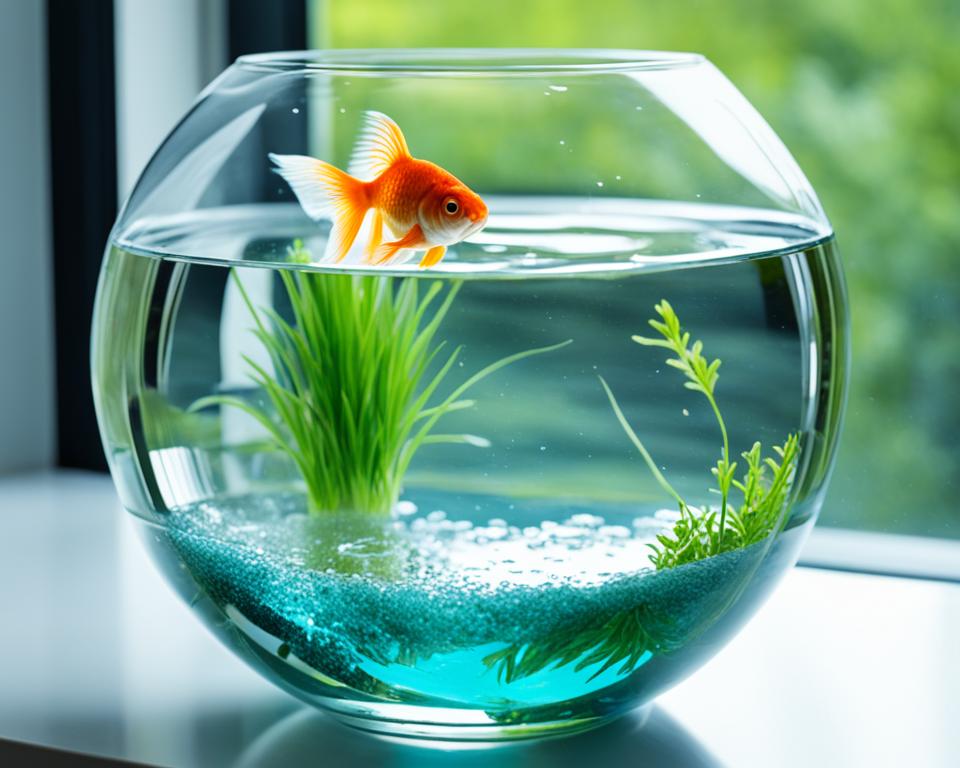
Maintaining Goldfish Health in Later Years
To ensure the well-being and longevity of your aging goldfish, it’s crucial to focus on health maintenance. Here are some key factors to consider:
- Proper Care: Provide your goldfish with a clean and spacious environment. Regularly clean the tank, maintain appropriate water parameters, and ensure proper filtration and aeration.
- Nutrition: Feed your aging goldfish a balanced and age-appropriate diet. Consult with a veterinarian or goldfish expert to determine the best food options for your geriatric goldfish.
- Disease Prevention: Take preventive measures to protect your aging goldfish from common diseases. Regularly monitor water quality, perform water changes as needed, and quarantine any new fish before introducing them to the tank.
- Environmental Enrichment: Provide stimulating and enriching elements in the tank, such as plants, decorations, and hiding spots. This can enhance your goldfish’s mental and physical well-being.
- Regular Check-ups: Schedule regular veterinary check-ups for your aging goldfish. A veterinarian experienced in aquatic animals can assess their overall health, provide necessary treatments, and offer guidance specific to geriatric goldfish care.
By following these guidelines and closely monitoring your goldfish’s health, you can help ensure they enjoy a comfortable and thriving life throughout their golden years
FAQs on How long do goldfish live
What factors contribute to goldfish lifespan variability?
Genetics, environment, and care all contribute to the lifespan of a goldfish. Some goldfish have been known to live for over 40 years, showcasing the potential for long lifespans in these fish.
Are there documented cases of long-lived goldfish?
Yes, there have been documented cases of goldfish living well beyond the average lifespan. Factors such as proper care, genetics, and a suitable environment can contribute to their longevity.
How does the environment impact goldfish longevity?
The environment plays a significant role in the lifespan of goldfish. Factors such as water quality, tank size, and habitat conditions can all affect how long goldfish live. Providing a suitable and well-maintained environment is crucial for ensuring their longevity.
How long do goldfish live in different habitats?
Goldfish can live in various habitats, including ponds and tanks. Goldfish can live well into their 20s or even 30s in larger ponds with adequate space and proper care. In smaller tanks or bowls, however, their lifespan may be significantly shorter.
What factors affect the survival of goldfish?
Several factors can affect the survival and lifespan of goldfish. Breeding practices, overcrowding in tanks or ponds, and the overall health of the goldfish population can all impact their longevity. Proper care and healthy population management practices can help ensure their survival.
How can I provide proper care for my goldfish to maximize their lifespan?
Proper care is essential for maximizing the lifespan of goldfish. This includes ensuring proper filtration and aeration in the tank, regular testing and maintenance of water quality, providing a balanced diet, and avoiding overfeeding. Also, providing adequate space as they grow is important.
Can goldfish live in bowls?
Keeping goldfish in bowls is not ideal for their longevity. Due to the limited space and lack of proper filtration, goldfish kept in bowls often have shorter lifespans, typically ranging from 3 to 9 months. Providing a suitable tank or pond is essential for the well-being and longevity of goldfish.
How can I extend the life of my goldfish?
There are strategies to extend the life of goldfish. Regular feedings with the right quantity and quality of food support their overall health and longevity. As goldfish grow, upgrading their tank size is essential to provide them with enough space to thrive and live a longer life.
What are the signs of aging in goldfish?
Goldfish, like any living being, show signs of aging. Recognizing these signs, such as changes in behavior and appearance, is important for understanding their needs in later years. Maintaining their health through proper care, nutrition, and disease prevention is crucial for ensuring their well-being and longevity.


